I figure the poor fellow must have been in a vacuum. For years the LRTC Wild Horse Workshops have involved hundreds of participants, mostly novices, in the pens gentling and training hundreds of unhandled BLM horses and burros straight from the adoption corrals, with activities taking place in as many as a dozen training pens simultaneously. While there have occasionally been a foot stepped on or someone bumped by a horse, there has never been a horse or participant hurt in any measurable way in any workshop training activity. Furthermore, to our knowledge no animal that was adopted at a workshop has ever been returned to BLM.
To pull this off we had to have a very strong safety program and training guidelines that is effective, safe and understandable to the participant. Frank Bell was one of the original clinicians who helped shape this program and his Seven Step Safety System is one of the references we use to ensure that safe, sane and humane activities take place in these programs.
- Bonding.
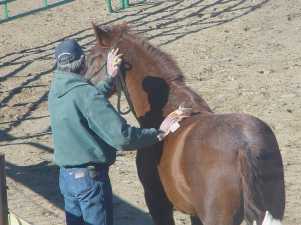 The concept in bonding is to make an incredible first impression with a horse. We touch the horse all over and eventually get to all those vulnerable places that they can't reach on their own. We will rub their eyes, get inside their nostrils, and stroke under their tails. We start with the horses' favorite spots and move to those spots that the horse typically guards.
The concept in bonding is to make an incredible first impression with a horse. We touch the horse all over and eventually get to all those vulnerable places that they can't reach on their own. We will rub their eyes, get inside their nostrils, and stroke under their tails. We start with the horses' favorite spots and move to those spots that the horse typically guards.
Some mares are particularly invested in guarding their bodies and it saves a great deal of time and stress later on if we need to get them totally relaxed and comfortable being touched all over from the beginning. We don't "pat" the horse but rather rub or scratch. The horse's body language can tell us if the pressure and intensity are correct or not.
Mouth Magic.
When a horse is emotionally locked up (acts stubborn,) we have found that oftentimes feathering the horse's tongue with our fingertips by gently inserting them through the bars of the horse's mouth can induce the horse to relax and become more "open minded."
If a horse has a particularly guarded spot we may place one hand in a favorite spot to
"ground" the horse while approaching the scary place with our other hand. "Grounding" seems to keep the horse connected with the concept that we are bonding, not acting like a predator.
Acceptance of Aids
As the horse gets comfortable with us we'll often introduce aids such as a flag, stick and other items. The art associated with this element is to introduce these items in a non-threatening manner (avoiding moving them directly at the horse) while in the context of a bonding session. The horse should be curious about these items and accept being touched all over by them. If the horse can regard all these things while in "left brain" mode, he will tend to behave more sensibly and predictably.
- Take and Give.
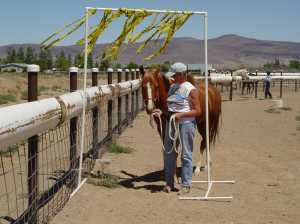 Take and Give is the basis for all communication. this exercise starts with applying
gentle downward pressure on the horse's lead or with a hand placed over the bridge
of the horse's nose. The horse will eventually find the
release by relaxing his neck and lowering his head. With bonding accomplished the
horse shouldn't be reluctant to do this. We have to be attentive and provide the
horse with release, not try to drag his head to the ground.
Take and Give is the basis for all communication. this exercise starts with applying
gentle downward pressure on the horse's lead or with a hand placed over the bridge
of the horse's nose. The horse will eventually find the
release by relaxing his neck and lowering his head. With bonding accomplished the
horse shouldn't be reluctant to do this. We have to be attentive and provide the
horse with release, not try to drag his head to the ground.
Once the horse understands the comfort derived from giving to pressure, we will start
asking the horse to add some lateral movement to the "Give," asking the horse to also
bend towards us in addition to the downward release.
We will also ask the horse to back up during the Take and Give exercises by using direct
pressure and by sending energy down (shaking) the lead rope. This keeps Take
and Give from becoming too redundant and boring, plus it allows us to cue Take and
Give when the horse is doing something else and maintains our control over our own
personal space in the horse's mind. Take and Give is an invitation for the horse to
connect with his handler and enter a relaxed state. It shouldn't become an excuse
for the horse to invade the handler's space.
Take and Give sets up all sorts of things. It establishes a pattern of giving to
pressure in a quiet and safe environment. When the horse gives to pressure, the
correct response feels good. Voluntary head lowering and neck flexing relaxes the
horse's neck muscles and appears to quiet his mind. Establishing a cue and response
pattern that consistently produces a comfortable outcome for the horse increases
confidence. Confidence facilitates heightened communication and heightened
communication increases handler / rider control. If the horse is startled or confronted
with a scary situation, subtle Take and Give by the handler can keep the horse from
jerking his head up into the sky in a "right brain" response and he will usually
confront an unfamiliar object or puzzle more sensibly and safely.
If the horse is flexing well in both directions and is relaxed during Take and Give, we
may reach over the horse's back and ask him to start flexing away from us. We don't
want to pull the horse's hind end into us but we can start to establish the
understanding that "Give" works both in our direction and away from us depending on
how the "Take" is applied. Also, Take and Give doesn't work unless the handler allows
the horse to give!
- Intimacy.
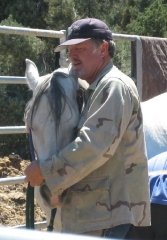 Once the horse is comfortable with Bonding and will relax to Take and Give, it's time
to take the next step. Intimacy involves the horse giving himself to his handler and
finding sort of a "zen" place up close and personal with his human companion.
Once the horse is comfortable with Bonding and will relax to Take and Give, it's time
to take the next step. Intimacy involves the horse giving himself to his handler and
finding sort of a "zen" place up close and personal with his human companion.
(This example is based on our standing on the horse's "on" side.) We start by standing
near the horse's shoulder and placing our
left hand just above the horse's nostrils. We will keep our hand here throughout the
exercise, whether the horse complies and bends toward us or refuses. He needs to
recognize that it is his choice to escape the pressure by giving to it.
Many horses don't understand our objective at first so we may lightly tickle the girth
area with our right hand while softly applying pressure to the horse's nose with our
left. Most horses will turn their heads in response. When they do we release pressure
while still maintaining contact and give the horse positive feedback.
We will repeat the exercise until the horse will willingly bend his neck and touch his
own flank. As the horse progresses we will adjust our "nose hand" and cover his
outside eye during the bends. Horses find this pattern to be comforting and they focus
on a relaxed "safety zone" which is the little pocket formed by the horse's bent body
and the handler. The ultimate objective is a horse whose head is relaxed and
compliant in one hand while feathering a "soft tail" (relaxed tail and rump) with the
other.
Repeating this exercise will give the horse an emotional "safe place" if he gets upset
where he can get quiet with his handler on the ground, or repeat the movement while
being ridden and asked to settle to a one rein stop. This pattern can also be "shaped"
for other purposes such as a "head hug" (shown above) if an otherwise edgy horse needs
to be vetted, vaccinated or trimmed.
- The Dance Begins.
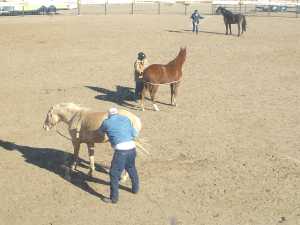 The next maneuver is what we traditionally called "counter turns." It's important for
the horse to face up to us, give to pressure and try to find that comfortable "float"
in the lead line, yet it takes a bit more thought, perception and general awareness for
the horse to turn away from the handler and circle back in response to pressure
on the line.
The next maneuver is what we traditionally called "counter turns." It's important for
the horse to face up to us, give to pressure and try to find that comfortable "float"
in the lead line, yet it takes a bit more thought, perception and general awareness for
the horse to turn away from the handler and circle back in response to pressure
on the line.
There are a variety of reasons that this maneuver is important, ranging from abstract
thinking to teaching the horse that it is OK and not a threat to "hand us off" from
one eye to the other while we are behind him. This is an element we will only attempt
when Bonding, Take and Give and Intimacy are working well since we're asking the horse
to swing his hind end past us and not fire with his hind legs when he feels the rope
across his rump!
In this element we need a fairly long horse handling lead, preferably a minimum of 15
ft. We will pass the lead along the far side of the horse's body and around his rump.
(If we are on the "on" side, this means we will have the line in our right hand.) Until
the horse is used to this maneuver it is important to keep the line up around the
horse's rump. If we let the rope drop around his legs when we apply pressure, we could
teach the horse to fire at the rope with his hind legs.
The objective is to set the horse in motion with our left hand, then by applying
pressure to the lead with our right we ask the horse to turn away from us, circle and
come back to us. Until the horse has accomplished this element these are a lot of
abstract thoughts and sensations for him to connect, so we need to be patient and
encourage the horse to make the correct decisions through our movements and body
position. We will repeat this exercise until the horse can do the maneuver quietly
and thoughtfully.
The Wind Down.
 The Wind Down is part of the "Dance" exercise that accomplishes several things.
It is a way to reduce
a horse's forward speed, helps refocus the horse if he scatters and helps establish
behavioral patterns that will improve the one rein stop once the horse is under saddle.
In The Wind Down the horse in motion is brought in, naturally slows down, and ends up
in an intimate "safety zone" with his handler.
The Wind Down is part of the "Dance" exercise that accomplishes several things.
It is a way to reduce
a horse's forward speed, helps refocus the horse if he scatters and helps establish
behavioral patterns that will improve the one rein stop once the horse is under saddle.
In The Wind Down the horse in motion is brought in, naturally slows down, and ends up
in an intimate "safety zone" with his handler.
After the horse has completed two or three circles, we will start the wind-down by
slowly gathering the lead and walking in toward the horse's hip bone. As we get closer
we will reach out a hand and stroke the horse's flank and rib area. At this point the
horse should be disengaging his hindquarters and may also be stepping across on his
forehand.
The differences between The Wind Down and simple disengagements are two fold. Firstly
the horse bends to a circle before disengaging. Secondly the horse should anticipate
coming to a safe, secure intimate place at the end of the wind down. If a horse becomes
uncorked on the line or under saddle, we don't want to jerk him off balance with
a sudden tug on the line or rein. Additionally, some runaways can be bent with a
rein and still gallop full out. Finally, when the horse does stop, we want him to
expect security and not blast off again the instant he senses a release on the line or
rein.
The Wind Down exercise establishes a pattern of flexion and reduction of speed before
the horse disengages, and it establishes a sense that everything will once again be
safe and secure at the end of the maneuver due to the repeated intimacy applied each
time at the end of the exercises. Like the frightened colt that settles when he comes
back to mama, we want the frightened or over stimulated horse to mentally and
emotionally come back to us in a consistent, safe and predictable manner.
Advancing the elements
When the horse has gotten handy with counter turns and winding down in both directions,
we can do a couple of more advanced things.
We can set up the counter turns so that the rope starts to contact the
hind legs rather than the rump, leaving ourselves clear of the "kicking zone" in case
we have misread the horse and he kicks at the rope. The objective is for him to accept
being touched around the legs with the rope and not first think about kicking things
that "surprise" him from behind. If he bolts forward we can immediately ask him to
circle and wind down (putting him back in left brain mode.)
Next we can add some dimension to the exercise by setting up combinations of counter
turns that end in wind downs and going from wind downs directly into counter turns.
We want to avoid getting so busy that we overwhelm the horse, but we want him to learn
to start looking for the cue that provides the "right answer."
If a horse stalls out and doesn't understand what we are asking, "pushing" the horse
in the right direction by moving the palm of our hand towards his eye is usually
safer and makes more sense to the horse than jerking on the rope, particularly when
setting up counter turns.
What the horse will have learned from counter turns and unwinding:
- Disengagement of hindquarters
- Desensitizing legs (kick suppression)
- Changing eyes
- Following a feel
- Moving away from pressure
This list continues in the next part of this feature.
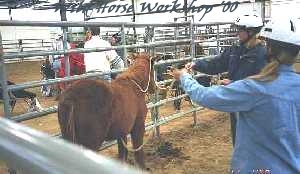

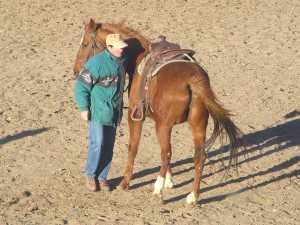
 The concept in bonding is to make an incredible first impression with a horse. We touch the horse all over and eventually get to all those vulnerable places that they can't reach on their own. We will rub their eyes, get inside their nostrils, and stroke under their tails. We start with the horses' favorite spots and move to those spots that the horse typically guards.
The concept in bonding is to make an incredible first impression with a horse. We touch the horse all over and eventually get to all those vulnerable places that they can't reach on their own. We will rub their eyes, get inside their nostrils, and stroke under their tails. We start with the horses' favorite spots and move to those spots that the horse typically guards.
 Take and Give is the basis for all communication. this exercise starts with applying
gentle downward pressure on the horse's lead or with a hand placed over the bridge
of the horse's nose. The horse will eventually find the
release by relaxing his neck and lowering his head. With bonding accomplished the
horse shouldn't be reluctant to do this. We have to be attentive and provide the
horse with release, not try to drag his head to the ground.
Take and Give is the basis for all communication. this exercise starts with applying
gentle downward pressure on the horse's lead or with a hand placed over the bridge
of the horse's nose. The horse will eventually find the
release by relaxing his neck and lowering his head. With bonding accomplished the
horse shouldn't be reluctant to do this. We have to be attentive and provide the
horse with release, not try to drag his head to the ground.
 Once the horse is comfortable with Bonding and will relax to Take and Give, it's time
to take the next step. Intimacy involves the horse giving himself to his handler and
finding sort of a "zen" place up close and personal with his human companion.
Once the horse is comfortable with Bonding and will relax to Take and Give, it's time
to take the next step. Intimacy involves the horse giving himself to his handler and
finding sort of a "zen" place up close and personal with his human companion.
 The next maneuver is what we traditionally called "counter turns." It's important for
the horse to face up to us, give to pressure and try to find that comfortable "float"
in the lead line, yet it takes a bit more thought, perception and general awareness for
the horse to turn away from the handler and circle back in response to pressure
on the line.
The next maneuver is what we traditionally called "counter turns." It's important for
the horse to face up to us, give to pressure and try to find that comfortable "float"
in the lead line, yet it takes a bit more thought, perception and general awareness for
the horse to turn away from the handler and circle back in response to pressure
on the line.
 The Wind Down is part of the "Dance" exercise that accomplishes several things.
It is a way to reduce
a horse's forward speed, helps refocus the horse if he scatters and helps establish
behavioral patterns that will improve the one rein stop once the horse is under saddle.
In The Wind Down the horse in motion is brought in, naturally slows down, and ends up
in an intimate "safety zone" with his handler.
The Wind Down is part of the "Dance" exercise that accomplishes several things.
It is a way to reduce
a horse's forward speed, helps refocus the horse if he scatters and helps establish
behavioral patterns that will improve the one rein stop once the horse is under saddle.
In The Wind Down the horse in motion is brought in, naturally slows down, and ends up
in an intimate "safety zone" with his handler.